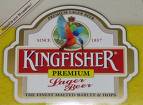Company: UB Group
Agency:JWT
Brand Count :169
Kingfisher is a classic case of branding success. This brand can even be termed as an iconic brand. A brand that had extended itself from beer to airlines can be equated
 to the Virgin brand. The brand is synonym with Beer in India. Now ask a young man from India what a Kingfisher is ? The most likely answer will be either Beer or Airline. The power of the brand has virtually made the bird a brand extension.
to the Virgin brand. The brand is synonym with Beer in India. Now ask a young man from India what a Kingfisher is ? The most likely answer will be either Beer or Airline. The power of the brand has virtually made the bird a brand extension.Kingfisher is a brand from the UB group stable.It is the largest selling beer brand in India commanding a market share of over 28% in the Rs 5000 crore Indian Beer market.The brand epitomises energy, youthfulness ,enthusiasm ,freedom but with a touch of professionalism.
United Breweries (the original name of the group) have a history dating back to 1857. The company came into existence as UB in 1915 with the merger of five small breweries . The Kingfisher brand was launched in the year 1980 ( the exact year of the birth of Kingfisher is not known,80's marked the real life of this brand).
The brand was the brain child of the current Chairman of UB group Mr Vijay Mallya. Reports says that Mr Mallya went to work in Calcutta as a part of mentoring program under Mr HP Bhagat. At that time the brands that were popular from UB stable was Kalyani Black label, Doctor's Brandy etc. Mr Mallya wanted to create an exciting brand and none of the existing brands did not impress him. He went back to Bangalore,searched archives and stumbled upon an old label with a Kingfisher in it. That marked the birth of the Iconic Kingfisher brand.
The major factor behind the success of Kingfisher brand is the Passion that Mallya have on the brand. When marketing theorists says that Marketing is a serious business, Mallya will tell you that Marketing is CEO's business. When the CEO takes interest in the brand and virtually promotes the brand in every occasion, there is so much equity generated on the brand. Like Virgin's legendary Richard Branson , Mallya also showed that the primary task for any CEO is to be passionate about the brand. While in most cases CEO comes into picture to deliver the annual shareholder's meet, Mr Mallya takes the brand with him everywhere.
Kingfisher brand is a unique marketing success story because it thrived in an environment where liquor/ beer advertising was banned in India. The owners have built the brand circumventing the ban on promotion. During 1997 , the brand roped in Ajay Jadeja and Sourav to feature in the campaigns. In 1996 the brand become the worldwide sponsors of the West Indies cricket team. But the brand was conscious to keep Kingfisher the star . The West Indies team personified the brand values of fun loving but successful team. The famous jingle " Oola la le lo" and the fun filled TVC rightly placed the brand as a fun loving one. Unlike brands like Pepsi which is focused on cricket, Kingfisher promotes all sports and the brand sponsors football stars and even Formula 1.
The brand directly talks to people who are Easy going, chilled out person who's always willing to take a break and party with the friends. But they are very professional and successful .
Most of the business reports try to relate the persona of Mr Mallya and the brand which I feel is unjustified. The brand Kingfisher does not derive any thing from the personality of Mr Mallya. The brand has its life of its own. Since the chairman is passionate about the brand, he takes personal interest in the brand . Other than that relating the person and the brand and trying to say that Mr Mallya is more flamboyant than the brand is doing unjust to the brand.

The brand also have a 360 degree approach to promotions tap
 ping all possible ways to communicate with its target audience. The brand sponsors lifestyle events and the Kingfisher Calender has attained a cult status with in 4 years of launch. During 2003-04 the brand logo got a make over and the Kingfisher started flying rather than sitting. The new logo signals the brand's vision to get to new heights. The new logo designed by Claessens was backed with lot of noise in the media.
ping all possible ways to communicate with its target audience. The brand sponsors lifestyle events and the Kingfisher Calender has attained a cult status with in 4 years of launch. During 2003-04 the brand logo got a make over and the Kingfisher started flying rather than sitting. The new logo signals the brand's vision to get to new heights. The new logo designed by Claessens was backed with lot of noise in the media.To circumvent the regulatory ban on surrogate advertising, the brand has launched into different categories like Mineral water and even into readymades taking a lesson from Wills.
2005 saw the UB group getting into the Airline business with its Kingfisher Airlines.The airlines became a brand to reckon with with in a year because the brand lived to its expectation and promise. Positioned as a funliner, the brand equity of the mother brand has been enhanced by this Extension ( can i call it an extension?).
Behind the glamour of swimsuits and parties , one should not forget the strategies that made the brand a super brand. The distribution and the point of promotion strategies of KF is excellent. The brand has maintained international quality but made sure that it is with in the reach of the Indian consumer.
source:kingfisher.com,businessline,magindia.











